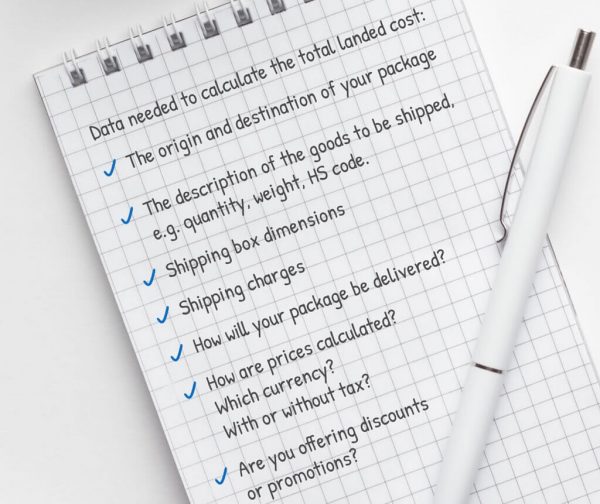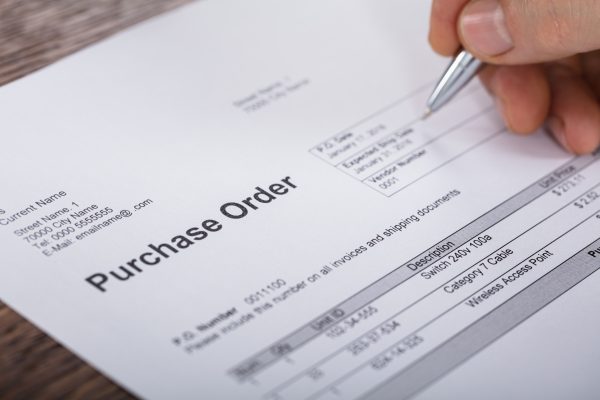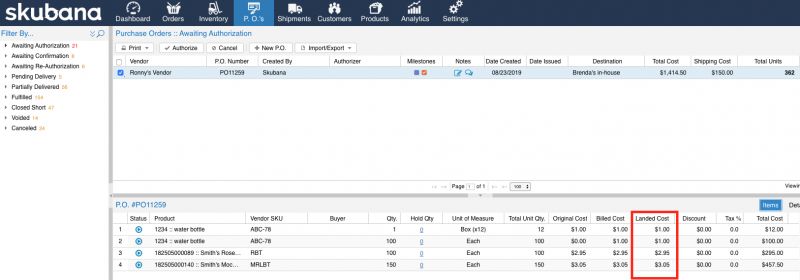On the surface, landed cost seems like a relatively simple concept that should be easy to keep track of. But, knowing your landed cost impacts your profitability.
What is Landed Cost?
Landed cost is the final cost of acquiring inventory for a product, captured from the initial purchase until it finally arrives at your destination, including freight costs, transportation fees, and customs duties.
It seems straight-forward, right? But many companies struggle to find their true landed cost per unit.
Every business should track landed cost, as it’s essential to monitor your inventory cost and how it impacts profitability, but many companies have difficulty doing it. Some use inaccurate estimations that can lead to overspending, some forget to include certain expenses, and some just don’t have the resources to track the landed cost of every item purchased.
These practices can lead to significant operational and financial issues for a company, particularly when it comes to business decisions. Without the proper profitability data, there is a higher risk of making ill-informed business decisions, which can lead to financial deficits that impact sales, marketing, and order fulfillment.
If you’re making blind estimations and losing money due to incorrect landed cost data, then you should reevaluate how you generate this number. We’ll walk through the basics of tracking landed cost, the hidden fees to look out for, and how automation can help you start making accurate cost calculations and monitoring your landed cost correctly.
How To Track Total Landed Cost?
While you may understand the concept of landed cost, you may not be aware of just how much goes into calculating it. Some of the standard fees one might add into landed cost include:
- Cost of goods sold (COGS)
- Insurance fees
- Freight fees
- Customs duties
- Domestic taxes
- Overhead costs
- Brokerage fees
- Shipping fees
While these are general costs, this list can grow depending on the specific industry you are in or if your products have specific handling needs that could lead to additional costs.
However, even if you know all the costs that need to be factored in, you won’t always have all your data when you need it. Suddenly this simple landed cost calculation becomes much more complicated to implement.
There are multiple parties involved through the delivery process, whether it be within your internal organization (purchasing, warehouse teams, operations) or external organizations (manufacturers, shipping providers, freight services, government agencies). Each party might process this data at different times or using various methods, which can lead to data inconsistency.
You might also receive final costs from different sources at different times. What if you don’t know how much a shipment cost the moment it arrives? What if you order multiple types of items in one shipment, or you run multiple facilities that result in different shipping costs for the same product? This inconsistency can lead to potential gaps in when costs can be finalized – sometimes taking weeks or months – which can become a massive headache.
Manually calculating landed cost with all of these variables becomes a bigger job than a business has time for. Managing spreadsheets and manually inputting these costs each time new information is made available becomes time-consuming and comes with a high risk of inaccuracy. Many companies opt to use inventory management software to automate landed cost calculations, but they can still run into issues if costs are missing or incorrect.
Collectively, the different variables of this process might cause companies to cut corners with landed cost or skip calculating it all together. But incorrectly tracking landing cost – or not tracking it at all – can have significant consequences for your business.

3 Reasons to Track Landed Cost
One of the most challenging yet crucial parts of running a store is finding the cheapest and most efficient way to conduct business. Shipping and freight cost is expensive, and if you’re not getting a good deal, your profit is going to sink fast.
Track Landed Cost to Optimize Cost of International Shipping
Landed cost is about more than the cost of goods. It’s about choosing the suppliers, shippers, and route that saves you the most money, avoids hefty fees, delivers your product on time, and mitigates any surprise costs. If you’re not monitoring this cost, it can lead to some regretful business decisions.
Tracking landed cost becomes more critical once you start dealing with international trade. The extra fees, import taxes, and other shipping metrics can change what seems like a great price. Sometimes, a supplier may offer a low price per unit, but the shipping costs and duties levied at you make it far less profitable than buying from onshore manufacturers. But if you want to be able to decide whether ordering from abroad or domestically is better for your business, you need to get a full picture of the costs you are already incurring so you can discover which options save the most money.
Track Landed Costs to Maximize Profits
Tracking landed cost is not just about optimizing your suppliers, either. Landed cost tracking provides the data needed to create competitive pricing that is also profitable, improve inventory efficiency, and determine the true cost of goods to understand what’s having the most significant impact on your bottom line.
The consequences of choosing not to track the landed cost can be disastrous. Companies could end up with a shipping/transportation company that’s severely damaging profits, turn their first foray into international trade a flop, drive away customers, or lose money with mispriced items.
Track Landed Costs to Improve Shipping Process
Not fully accounting for landed cost also makes the jobs of sales managers, accountants, and merchandise planners harder. How can they accurately track revenue, find ways to save money, or figure out what merchandise to buy and where to get it from if such a crucial statistic is inaccurate?
Inaccurate landed cost leads to an inefficient supply chain that sends money flowing out the door. Don’t neglect to monitor landed costs. You need a system in place so you can more accurately track your inventory costs.

How to Calculate Landed Cost
Keeping track of your landed cost involved referencing your invoices and other records to determine how much a unit costs. Assuming you’ve obtained and organized these records appropriately, here are some of the most common factors to look for that are used to calculate landed cost:
- Unit Cost: The purchase price of each unit of the product.
- Shipping: The cost of transporting your items. Packing/crating, shipping, handling, freight costs, and transportation. If you're shipping internationally prepare to pay higher freight costs, and don't forget transportation costs from the harbor to your warehouse as well. Shipping should capture all fees that contribute directly to the physical movement of your goods.
- Customs: All the government-imposed fees your items racked up during shipping. Customs include taxes and VAT, customs duties, levies, and harbor fees. Tracking customs is very important when dealing with international shipping. If you use brokers, this might also include any brokerage fees.
- Risk: Fees paid to protect you and your products. Insurance, compliance, quality assurance, and safety stock inventory -- anything you purchase to mitigate disaster.
- Overhead: Operating costs and miscellaneous fees. Exchange rates, payment processing fees, and due diligence costs are all potential factors to include.
Landed Cost Formula
Quantify all of these and add them together to get your landed cost calculation. Here is the example formula:
Unit Cost + Shipping + Customs + Risk + Overhead = Landed Cost Per Unit
Be careful to pull this information for every purchase order, as discounts or free shipping offers may cause costs to vary from order to order. The same product can have different landed cost values across purchase orders.
Here's an example in action.
Let’s say you purchased 100 units for $15 each, for a total of $1500. Shipping came out to $200, duties are at 3% (or $45), and you spent $200 on insurance. Exchange rate fees led to you paying $100.
To make this calculation work, add the fees to calculate your landed cost on the entire order. Then divide that total by the number of units in the PO to determine your price per unit.
$1500 + $200 + $45 + $200 + $100 = $2,045
$2,045/100 = $20.45
Your final landed cost per unit is $20.45.
If your product made up only part of the shipment and was group with other products, there are different ways to approach it. You can split the collective shipping cost to each unit included within the purchase order. This is the most straightforward approach, but there are ways to get more granular.
You can split the cost of shipping per unique product in the shipment. This can be applied by splitting the percentage of weight or the percentage of space the product contributes to the delivery.
Collecting The Right Information for Landed Cost
While the formula itself is quick to solve, collecting the info on the products you sell every time you order a shipment is the hard part. Invoices can take weeks to come in, or you may struggle to track all these factors in any reasonable amount of time.
For example, manufacturers might not confirm total freight costs until weeks after a shipment has arrived at your warehouse. If you are manually tracking landed cost using spreadsheets, this will require you to retroactively update numbers in your sheets to account for any fluctuations in prices. Then this recalculated data would need to be factored into any other grids or software you are using to track your profits and losses.
Although inventory management tools and automation can’t magically solve all issues – like shipping invoices that take too long to arrive – it can improve the accuracy of your data, speed up profit calculations, and simplify manufacturer or supplier evaluations.
Resources for tracking landed cost
Multiple tools can be used to track inventory costs both manually and with automation. Specialized calculators can shave off some of the difficulty of calculating each number by hand or help anticipate the costs you might see.
Here are a few you can try:
- International Shipping Calculator: A great tool to help you estimate how much international shipping will cost. It also shows how much this shipment will cost your customers.
- International Freight Rate Calculator: Instantly calculate freight rates for types of containers shipping to and from any country. Also, look at this site’s other freight calculators. Some of the tools may require an account for access.
- Duty Calculator: Figure out duty rates for any country and category of product.
- True Cost of Goods Import Calculator: This helps you calculate how much shipping is costing you.
- VAT Calculator: For those doing business in the UK, you’ll need to include VAT customs duties as well. VAT doesn’t change very often, but it’s still good to make sure you’re using the right rates with an online calculator.
- Currency Calculator: Easily figure exchange rates with an accurate, up-to-date tool.
Even with sites like these at your disposal, landed cost is still going to take a long time to calculate. Keeping up with landed cost requires staff to manage this data, which may take hours of backtracking against purchase orders to update your costs. It can take weeks for final invoices to process, and if you frequently order from several different vendors, the task of updating your records can be time-consuming.
By using automation, you can cut expenses and condense hours of calculations into a matter of seconds. No growing business is sustainable without automation. Landed cost is just one of many metrics you need to consider, and it will become overwhelming for your employees as you expand SKUs, work with new vendors, and increase inventory volumes.
Inventory management software with purchase order capabilities can streamline this process. Extensiv Order Manager’s Purchase Order module gives companies the ability to develop, process, and adjust POs with their vendors directly within the system. Even when a PO closes within the system, users can make adjustments to capture updated costs accurately. We've also created this handy guide on how to create the perfect purchase order template.
The level of flexibility Extensiv Order Manager offers provides several efficiencies for tracking landed cost:
- Each PO generated within the system includes a shipping cost section, as well as an aggregate cost section for any variable costs that are split evenly across units within the PO.
- POs also include a “landed cost” section that allows you to adjust this value per each SKU within the PO (aggregate costs are applied on top of this value).
- Extensiv Order Manager tracks inventory value and COGS using the first-in, first-out (FIFO) method, so if the landed cost for a product fluctuates from PO to PO, it properly attributes COGS based on the order in which the inventory was received.
- All POs closed or received within Extensiv Order Manager can be retroactively adjusted to account for costs finalized after a shipment. These updates are automatically applied to all analytics reports, providing consistency in your data.

Interested in seeing Extensiv Order Manager’s purchase orders in action? Let us show you.
Inventory automation will handle all the complicated calculations for you, figuring landed cost entirely in the background and making any necessary manual updates a one-step process.
Manual tracking is no longer necessary, thanks to the accessibility of inventory management software. Investing in a multichannel inventory management tool that includes landed cost capabilities can help free you and your accountants’ time to focus on more critical issues.
Automate Landed Cost Tracking with Extensiv Order Manager
Tracking landed cost often slows down due to late invoices or net 60 payment terms, mixed shipments or confusion in your calculations, and mistakes made by employees. However, it is a necessary process that every business should prioritize calculating accurately and efficiently. With Extensiv Order Manager's inventory management software automating purchase order, accounting, and analytics is simple.
There’s no reason to get hung up on landed cost when software can make the process easier and scalable. Automating processes like this can reduce costs and identify areas where you can improve profitability.
Find the right process and tools to help track landed costs to open up your business to the world of global trade without worrying about the risk of financial mistakes bringing your business down.
-
You’ll read about:
Be the first to know
Subscribe to our newsletter






